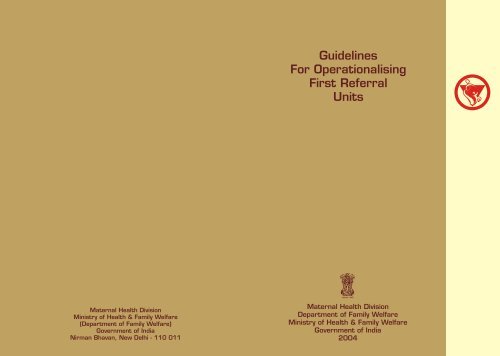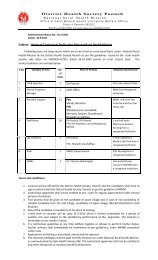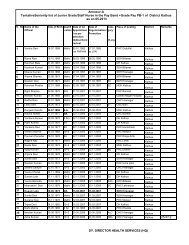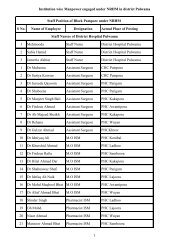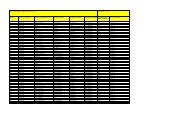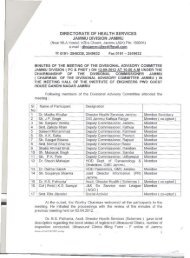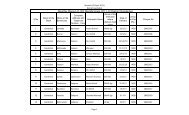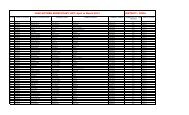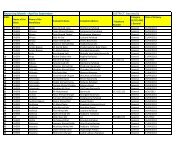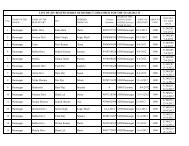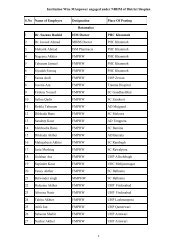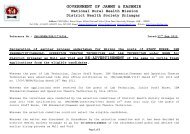Guidelines For Operationalising First Referral Units - National Rural ...
Guidelines For Operationalising First Referral Units - National Rural ...
Guidelines For Operationalising First Referral Units - National Rural ...
You also want an ePaper? Increase the reach of your titles
YUMPU automatically turns print PDFs into web optimized ePapers that Google loves.
<strong>Guidelines</strong><br />
<strong>For</strong> <strong>Operationalising</strong><br />
<strong>First</strong> <strong>Referral</strong><br />
<strong>Units</strong><br />
Maternal Health Division<br />
Ministry of Health & Family Welfare<br />
(Department of Family Welfare)<br />
Government of India<br />
Nirman Bhavan, New Delhi - 110 011<br />
Maternal Health Division<br />
Department of Family Welfare<br />
Ministry of Health & Family Welfare<br />
Government of India<br />
2004
<strong>Guidelines</strong><br />
<strong>For</strong> <strong>Operationalising</strong><br />
<strong>First</strong> <strong>Referral</strong><br />
<strong>Units</strong>
Preface<br />
Reduction in maternal mortality rate is the stated goal for <strong>National</strong> Population Policy, <strong>National</strong> Health<br />
Policy and Tenth Five Year Plan and is also one of the Millennium Development Goals (MDG) to which<br />
the country is a signatory and has to respond.<br />
Maternal mortality in India continues to remain unacceptably high. Historical evidence at the global<br />
level has demonstrated that it is possible to bring down maternal mortality effectively if a package of<br />
obstetric services is provided within reach of the communities and the families. It is in this context that<br />
efforts were initiated in 1992 with the implementation of the Child Survival and Safe Motherhood<br />
(CSSM) Programme for upgrading the existing community health centers and sub-district hospitals into<br />
<strong>First</strong> <strong>Referral</strong> <strong>Units</strong> (FRUs), to be equipped for providing delivery of emergency obstetric care to pregnant<br />
women with complications. Over the years, a number of steps have been taken under the Reproductive<br />
and Child Health ( RCH) Programme for facilitating the operationalisation of these FRUs. These have<br />
included funds for operationalising Operation Theatre (OTs) and Labour Rooms (LRs), supply of<br />
equipment kits, supply of drug kits containing emergency obstetric care drugs and funds for hiring of<br />
Anaesthetists from private sector. Drugs and Cosmetics Rules have also been amended to enable setting<br />
up of Blood Storage <strong>Units</strong> in the institutions designated as <strong>First</strong> <strong>Referral</strong> <strong>Units</strong> (FRUs). Despite all these<br />
efforts, not many FRUs identified by the State Governments have become fully operational for provision<br />
of 24-hours Emergency Obstetric and Child Health care services.<br />
The Maternal Mortality Rate (MMR) at the <strong>National</strong> level continues to be above 400 per 100,000 live<br />
births. The MMR in many major states particularly those, which are part of the Empowered Action Group<br />
(EAG), is much above the <strong>National</strong> average. This situation is a major cause of concern and it is imperative<br />
that focused efforts have to be made for making the <strong>First</strong> <strong>Referral</strong> <strong>Units</strong> fully operational, in case we have<br />
to meet the <strong>National</strong> objective of bringing down the MMR to less than 100 by the year 2010.<br />
Under the forthcoming Reproductive and Child Health Programme, Phase II, efforts have to be made for<br />
operationalising 2000 FRUs in a phased manner. The guidelines on operationalisation of FRUs have been<br />
prepared to assist the states to plan for operationalising of the FRUs. Proper planning at this stage will also<br />
help the states in determining the type and quantum of assistance required by them for different inputs<br />
while planning for the implementation of RCH-II. The guidelines are basically suggestive in nature and the<br />
states can take suitable initiatives while planning for various activities towards operationalisation of these<br />
FRUs identified by them. Funding for these activities will be under RCH-II and would accordingly be subject<br />
to the norms for such funding and details of accountability as would be prescribed under the RCH-II.<br />
I would like to acknowledge the efforts put by the Maternal Health Division of this Department in<br />
preparing the guidelines. I am sure this effort will go a long way not only in planning and<br />
operationalising of FRUs, but also in ensuring uniform and good quality obstetric services at these <strong>First</strong><br />
<strong>Referral</strong> <strong>Units</strong> (FRUs).<br />
24th July, 2004<br />
(P. Hota)<br />
Secretary (FW)<br />
Department of Family Welfare<br />
Ministry of Health & Family Welfare<br />
Government of India<br />
- i -
Acknowledgements<br />
Contents<br />
Operationalisation of <strong>First</strong> <strong>Referral</strong> <strong>Units</strong> (FRUs) is an important component of the Reproductive and<br />
Child Health (RCH) Programme. It is hoped that the guidelines will help the States in planning for<br />
operationalising the FRUs for strengthening Emergency Obstetric and Child Health care at the <strong>First</strong><br />
<strong>Referral</strong> units.<br />
I gratefully acknowledge the encouragement and guidance provided by Shri P. Hota, Secretary in<br />
Department of Family Welfare. I am also thankful to Shri S.S. Brar, Joint Secretary (RCH) for his inputs<br />
and help during the preparation of these guidelines.<br />
I would specifically like to acknowledge the contributions and efforts of Shri J. P. Misra, Programme<br />
Advisor, European Commission for technical assistance and Dr. Arvind Mathur, NPO, WHO India, in<br />
the preparation of the guidelines. The draft guidelines were discussed also with the State Programme<br />
Officers and Technical Experts. Their valuable suggestions have been incorporated while preparing<br />
these guidelines and I would like to thank all of them for their contribution.<br />
I would like to express my sincere appreciation for the hard work and contribution put in by<br />
Dr. Narika Namshum, Dr. Himanshu Bhushan and Dr. Ira Ray for bringing out these guidelines.<br />
I acknowledge the help provided by Mrs. Reeta Madan and Shri Pradeep Kumar Sohpaul for their<br />
secretarial help in putting together the document.<br />
Sl. No. Contents Page<br />
1 Introduction 1<br />
2 Critical determinants of a <strong>First</strong> <strong>Referral</strong> Unit (FRU) 2<br />
3 Points to be considered while selecting the facility 3<br />
4 Equipment: Review past receipts 4<br />
5 Human resources: Re-deployment and multi-skilling 5<br />
6 <strong>Referral</strong> transport 6<br />
7 Functional / financial autonomy 7<br />
8 Selection: The first step 7<br />
9 Annexures<br />
Annex-I: Number of FRUs reported by the states 8<br />
Annex-II: Extracts from <strong>National</strong> guidelines on blood storage facilities at FRUs 9<br />
Annex-III: <strong>For</strong>mats to be used for selection of sites 12<br />
Annex-IV: Equipment kit supplied under CSSM 17<br />
( Dr. V. K. Manchanda )<br />
Deputy Director General<br />
Maternal Health Division<br />
Department of Family Welfare<br />
Ministry of Health & Family Welfare<br />
Government of India<br />
- ii -<br />
- iii -
Introduction<br />
1.1 Historical background<br />
1.1.1 It is estimated that for every 100,000 live births, 407 pregnant women die every year in<br />
India due to causes related to pregnancy and childbirth. The major causes of these deaths<br />
have been identified as Anaemia, Haemorrhage (both Ante and Post-Partum), Toxemia<br />
(Hypertension during pregnancy), Obstructed Labour, Puerperal Sepsis (Infections after<br />
delivery) and unsafe Abortions. Over the years, efforts to reduce Maternal Mortality and<br />
Morbidity have included providing family planning services, improving essential obstetric<br />
care including Ante-natal Care, Safe/Institutional Deliveries, Prophylaxis and treatment of<br />
Anaemia and Post-natal Care and Emergency Obstetric Care.<br />
1.1.2 Complications associated with pregnancies are not always predictable. Therefore,<br />
provision of Emergency Obstetric Care as close to the community as possible was taken<br />
up under the Child Survival and Safe Motherhood (CSSM) Programme by setting up <strong>First</strong><br />
<strong>Referral</strong> <strong>Units</strong> (FRUs) at the community health centers/sub-district level hospitals. Central<br />
assistance was provided to 1724 FRUs identified by the States (see Annex I), in the form of<br />
12 types of equipment kits which were considered necessary for carrying out<br />
Laporotomies, Caesarean Sections and other surgical interventions for Emergency<br />
Obstetric Care and New-born Care. However, most of the identified FRUs could not<br />
become fully operational due to:<br />
(i)<br />
(ii)<br />
(iii)<br />
(iv)<br />
Lack of provision of emergency drugs<br />
Inadequate infrastructure in terms of Operation Theatre and Labour Rooms<br />
Non- availability of blood banking facilities, and<br />
Lack of skilled manpower, particularly Anaesthetists and Gynaecologists<br />
1.1.3 Under the RCH programme, provision has been made for supply of drug kits to the FRUs<br />
in the form of Emergency Obstetric Drug kits containing 65 items of drugs @ 3 Kits in 'C'<br />
Category Districts and 2 Kits in each of the 'B' Category Districts in the states. The States<br />
have also been provided assistance for civil works to upgrade the infrastructure for<br />
Operation Theatres and Labour Rooms.<br />
1.1.4 Drugs and Cosmetics Rules have been amended and now it is possible to set up blood<br />
storage centers at the sub-district level health facilities identified as FRUs. <strong>Guidelines</strong> for<br />
setting up blood storage facilities at FRUs have been prepared by a group of experts and<br />
circulated separately (see Annex-II for key provisions of the guidelines).<br />
1.1.5 The experience indicates that lack of specialist/trained providers (Anaesthetists and<br />
Gynaecologists) is perhaps the single most important cause for inadequacy in provision<br />
of emergency care in Government hospitals particularly in rural areas. In order to<br />
improve availability of Anaesthetists, provision was made in the RCH Programme for<br />
hiring the services of private Anaesthetists for conducting emergency operations at a<br />
payment of Rs. 1000/- per case. However, the expenditure reports indicate that the State<br />
Governments have not been able to use the financial assistance made for this purpose<br />
which may be due to many factors, including non-availability of such specialists even in<br />
the private sector.<br />
- 1 -
1.2 Tenth Plan: Recommended approach<br />
1.2.1 The working group on health care for women and children for Tenth Five Year Plan have<br />
identified establishment of fully functional and operational FRUs as the priority area for<br />
the provision of Emergency Obstetric and New-born Care. The group has<br />
recommended as under:<br />
"It is imperative that the existing infrastructure and specialist manpower at FRUs/CHCs is<br />
looked into critically and re-organized, and mis-matches between infrastructure and<br />
manpower corrected. At the first instance it would be desirable to ensure provision of<br />
quality Emergency Care Services at least at the district hospital and sub-district hospital<br />
followed by FRUs/CHCs. Thus, developing some FRUs in a district by ensuring that they<br />
have the required number of specialists in position or have access to the services of<br />
specialists on call, would be a preferred option rather than having a number of FRUs<br />
which may not be providing full range of services. The information on location of such<br />
emergency services/FRUs will be made available to all villages in the area so that the<br />
population knows where they should reach for getting appropriate emergency care. The<br />
provision of emergency care has also to be supported by appropriate referral services<br />
from sub-centers to PHCs and from PHCs to the functioning <strong>First</strong> <strong>Referral</strong> <strong>Units</strong><br />
providing emergency services."<br />
1.2.2 In view of the foregoing, it is considered imperative that the States look at the existing<br />
facilities and identify clearly their requirements for putting into place fully functional<br />
FRUs. It is envisaged that by the end of the Tenth Five Year Plan, each district should have<br />
at least 3-4 fully functional facilities which are equipped to provide the full range of<br />
Emergency Obstetric and New-born Care on a round-the-clock basis.<br />
1.2.3 To realize the above objective, an exercise will need to be undertaken for mapping the<br />
existing health facilities, available manpower and other resources for each district. This<br />
exercise will facilitate proper placement of the available resources and at the same time<br />
will bring out additional requirements in terms of training, equipment and infrastructure<br />
required for operationalising the identified CHCs/sub-district hospitals as FRUs. To<br />
facilitate this exercise, formats have been designed and are given in Annex III {<strong>For</strong>mats I,<br />
II & III}. Based on this exercise, it should be possible to draw the district-wise action plans<br />
for operationalising FRUs in a phased manner. Consolidation of the district plans at the<br />
state level will thus bring out the overall requirements of the State in various areas, like<br />
infrastructure, equipment, manpower and training needs for operationalising FRUs<br />
during the Tenth Plan.<br />
1.2.4 The guidelines below are an attempt to facilitate the planning exercise by the States and<br />
also take into account the recommendations of the <strong>National</strong> workshop organized in<br />
1999 for operationalisation of FRUs, in which all the States, donor agencies, experts and<br />
programme officers of the Department of Family Welfare participated.<br />
1.2.5 The suggestions/recommendations made below also draw upon two consultative<br />
meetings with the States and experts held in connection with the proposed second phase<br />
of the RCH programme.<br />
provide round-the-clock services for Emergency Obstetric and New-born Care, in<br />
addition to all emergencies that any hospital is required to provide (Box-1).<br />
Box-1: Minimum services to be provided by a fully functional FRU<br />
• 24-hour delivery services including normal and assisted deliveries<br />
• Emergency Obstetric Care including surgical interventions like Caesarean Sections(*)<br />
and other medical interventions<br />
• New-born Care(*)<br />
• Emergency Care of sick children<br />
• Full range of family planning services including Laproscopic Services<br />
• Safe Abortion Services<br />
• Treatment of STI / RTI<br />
• Blood Storage Facility (*)<br />
• Essential Laboratory Services<br />
• <strong>Referral</strong> (transport) Services<br />
(*): Critical determinants of functionality<br />
2.1.2 It should be noted that there are three critical determinants of a facility being 'declared'<br />
as a FRU: availability of Surgical Interventions, New-born Care and Blood Storage<br />
Facility on a 24-hour basis.<br />
2.1.3 The planning effort in relation to operationalising the FRUs, therefore, has to focus on<br />
carefully selecting such existing CHW/Sub-district hospitals which can be quickly<br />
equipped to handle all obstetric emergencies including those requiring surgical<br />
interventions like the Caesarean Section.<br />
2.1.4 It may also be noted that the above critical interventions may currently not be available<br />
even in some district headquarter hospitals, particularly in the newly created districts in<br />
the EAG States. Therefore, the operationalisation effort must be carefully sequenced,<br />
and should start by making the district hospital fully operational as a <strong>First</strong> <strong>Referral</strong> Unit.<br />
2.1.5 Given the scarcity of resources, particularly the specialists, even the best endowed States<br />
have carefully avoided a normative approach (e.g. of declaring all CHCs as FRUs). <strong>For</strong><br />
example, Maharashtra carried out a detailed assessment exercise covering all CHCs<br />
which revealed that it would not be feasible to provide the 24-hour surgical<br />
interventions at all CHCs. The State, therefore, selected 3-4 CHCs in every district for<br />
provision of FRU services. <strong>For</strong> the remaining CHCs, the service package has been<br />
defined at a lower level of competence.<br />
Points to be considered while selecting the facility<br />
Critical determinants of a <strong>First</strong> <strong>Referral</strong> Unit<br />
2.1 Recommended service package<br />
2.1.1 An existing facility (district hospital, sub-divisional hospital, community health centre<br />
etc.) can be declared a fully operational <strong>First</strong> <strong>Referral</strong> Unit (FRU) only if it is equipped to<br />
Points to be considered while selecting sites for opertionalising FRU services<br />
3.1 Infrastructure needs<br />
3.1.1 To be able to perform the full range of FRU functions, a health facility must have the<br />
following physical infrastructure:<br />
This may call for selecting a smaller facility in preference to some otherwise 'larger' facilities. <strong>For</strong> example, a brand new CHC may have to be<br />
ignored because it may be too close to the district headquarter or it may be difficult to retain its manpower because of its location.<br />
- 2 -<br />
- 3 -
• A minimum bed strength of 20-30. However, in difficult areas as the North-East<br />
States and the under-served areas in the EAG States, this could be relaxed to 10-12<br />
beds initially.<br />
• A fully functional operation theatre equipped for undertaking anaesthetic and<br />
emergency surgical procedures including Caesarean Sections and Laporotomies.<br />
• A fully operational Labour Room.<br />
• An area earmarked and equipped for New-born Care in the Labour Room and<br />
also in the ward.<br />
• A functional laboratory with facilities for all essential investigations.<br />
• Blood storage facility as per the guidelines issued by Govt. of India (GoI).<br />
• 24-hour water supply.<br />
• Arrangements for waste disposal.<br />
• Regular electricity supply with back-up arrangements to ensure uninterrupted supply<br />
to the operation theatre and labour room, cold chain and blood storage facility.<br />
• Telephone connection.<br />
• Ambulance (owned or arranged through local hiring).<br />
3.2 Selection of sites<br />
3.2.1 Under the RCH Programme funds were provided for civil works related to<br />
operationalisation of operation theatre, labour rooms and provision of regular water<br />
supply etc. at the CHCs and district hospitals. Similarly, civil works have been<br />
undertaken at many sub-district facilities as part of the Health Systems Projects in the<br />
concerned States. It is expected, therefore, that the physical infrastructure is already in<br />
place in many sub-district health facilities in every district. This should be taken into<br />
account while carrying out the selection process.<br />
3.2.2.However, situations could arise where the previous investments for infrastructure<br />
strengthening may not have been made in facilities which are otherwise optimally<br />
located and are more likely to attract specialised manpower than the facilities which<br />
were not taken up for such strengthening. <strong>For</strong> example, investments made to upgrade a<br />
CHC located within a few kilometers of the district hospital may not lead to much<br />
improvement in the availability of emergency services because (a) the people are likely<br />
to by pass it and go to the district hospital and (b) the staff posted at such facility would<br />
tend to stay in the district headquarter.<br />
3.2.3 The objective of ensuring proper selection should be to develop a network of 3-4<br />
facilities in the district in such a way that these together with the district hospital can<br />
ensure that all emergency cases in the district can access the nearest facility within a<br />
maximum travel time of 1 hour.<br />
Equipment: Review past receipts<br />
4.1 Twelve types of equipment kits (Kit-E to Kit-P) were designed under the CSSM programme<br />
(See Box-2 below) and supplied to the States. Detailed facility surveys carried out in some<br />
places have indicated that substantial part of these supplies may still be lying unused in<br />
some CHCs which do not have the requisite physical infrastructure and/or the necessary<br />
human resources for utilizing the equipment. Some equipment for blood storage have<br />
also been supplied under the Aids Control Programme by NACO to a number of subdistrict<br />
facilities. Similarly, States covered under the Health Systems Projects have also<br />
procured and supplied equipment for the district and sub-district level facilities.<br />
Box-2: Equipment kits supplied under CSSM Programme<br />
Kit-E: Standard Surgical Set-I (instruments) FRU<br />
Kit-F: CHC Standard Surgical Set-II<br />
Kit-G: IUD Insertion Kit<br />
Kit-H: CHC Standard Surgical Set-III<br />
Kit-I: Normal Delivery Kit<br />
Kit-J: Standard Surgical Set IV<br />
Kit-K: Standard Surgical Set-V<br />
Kit-L: Standard Surgical Set VI<br />
Kit-M: Equipment for Anaesthesia<br />
Kit-N: Equipment for Neo-natal Resuscitation<br />
Kit-O: Equipment for Laboratory Tests and Blood Transfusion<br />
Kit-P: Materials Kit for Blood Transfusion<br />
4.2 It is clear that an assessment needs to be carried out as part of the process of<br />
operationalising FRUs so that the equipment already available in a given district can be<br />
taken into account while determining the requirement of equipment. A stock taking at<br />
the district level will thus be a necessary exercise and will facilitate shifting of the<br />
equipment lying un-utilized at some facilities to those facilities where these may be<br />
required. Details of the various equipment kits is in Annexure IV.<br />
Human resources: Re-deployment and multi-skilling<br />
5.1 Policy options for human resource management<br />
5.1.1 The community health center was envisaged to be a fully functional FRU (defined to<br />
mean a facility providing full range of FRU services including C-section, along with<br />
facilities for handling other medical emergencies) and, accordingly, a minimum<br />
strength of 4 medical officers (who are either qualified or especially trained to work as<br />
surgeon, obstetrician, physician and pediatrician) was recommended. Facilities<br />
selected for operationalising FRU services should, therefore, aim to provide a similar or<br />
increased strength of medical personnel. In addition, adequate number of nursing staff<br />
to work in Operation Theatre, Labour Room and In-patient wards will also need to be<br />
carefully determined.<br />
5.2 Re-deployment & multi-skilling<br />
5.2.1 Re-deployment of the resources existing within the districts is one of the important step.<br />
This has been gainfully done in West Bengal. Based on a review, the State Government<br />
of West Bengal announced an infrastructure rationalization and manpower redeployment<br />
policy with a view to improve institutional care in the State. The key features<br />
of the policy announcement are as follows:<br />
• Strengthening of Block PHCs (BPHCs) and PHCs will be done in a need based<br />
manner after actual assessment for each individual institution. This would include<br />
rehabilitation of the buildings, provision of new equipment as well as posting of<br />
additional manpower.<br />
• All the block PHCs shall have minimum 30 indoor beds with complete facilities for<br />
institutional delivery and usual indoor treatment care.<br />
• Efforts will be made to provide same facilities in the BPHCs as are available in rural<br />
- 4 -<br />
- 5 -
hospitals (Community Health Centres as per GoI nomenclature).<br />
• Well-functioning PHCs running with indoor facilities will be identified and their<br />
infrastructure strengthened.<br />
• The existing manpower position of the BPHCs and PHCs (which are well<br />
functioning) will be strengthened by withdrawing and posting of manpower from<br />
PHCs that are providing only OPD services.<br />
• All the staff of PHCs that are providing only outdoor services shall be withdrawn<br />
and re-deployed in BPHCs and PHCs running with indoor. Manning of OPD of<br />
these PHCs shall be done from the BPHCs by deployment of manpower for<br />
required work on rotation basis.<br />
5.2.2 Provision of other support services like blood storage, Laboratory services, pharmacy<br />
services should be planned primarily on the basis of multi-skilling and re-deployment of<br />
available paramedical staff.<br />
5.2.3 After selection of the facilities to be operationalised as FRUs and assessment of available<br />
manpower and other resources has been completed, it would be necessary to re-deploy<br />
the specialists and other manpower to the facilities designated as FRUs. The State<br />
Government has to steer this process since the process may also require inter-district redeployment.<br />
5.2.4 Considering the general lack of specialists particularly that of anaesthetists, it is<br />
imperative to train the MBBS doctors in life saving anaesthetic skills for emergency<br />
obstetric care. A training programme on this has been designed for this purpose and a<br />
pilot course already implemented by officers of Chhattisgarh. The course module for the<br />
training, to be organized in selected medical colleges, is in the process of being finalized<br />
and will be shared with States as soon as they are available.<br />
5.2.5 Similar training programme is being designed by the Federation of Obstetrical and<br />
Gynaecological Societies of India (FOGSI) to train the MBBS doctors for management of<br />
obstetric emergencies (including C-section) and New-born Care. This training<br />
programme is also likely to be available shortly.<br />
5.2.6 Multi-skilling training of paramedical workers will also be necessary in the critical area of<br />
Obstetric Care, New-born Care and Blood Storage and Laboratory Services.<br />
<strong>Referral</strong> transport<br />
6.1 Since most of the referrals originate from the field, the information on availability of<br />
emergency services at FRUs will have to be effectively disseminated to all villages in the<br />
area so that the population knows where they should reach for getting appropriate<br />
emergency care.<br />
6.2 The provision of emergency care has to be supported by (i) appropriate referral transport<br />
from the periphery to the functioning <strong>First</strong> <strong>Referral</strong> <strong>Units</strong> providing emergency services<br />
and (ii) also from FRUs to district/tertiary level institutions. State Government will have to<br />
develop administrative mechanisms to facilitate transportation of patients from the field<br />
to the FRU on the one hand and from the FRU to higher facilities (district hospital and/or<br />
tertiary care facility), if required, on the other.<br />
6.3 Providing Government procured vehicles should not be seen as the only option for<br />
referral transport/linkage. The option of providing funds to the facility in-charges,<br />
together with administrative and financial powers to make local arrangements is a<br />
recommended option.<br />
Functional/financial autonomy<br />
7.1 FRU operationalisation is not just about more equipment and funds; it is about<br />
empowering the facilities to respond to emergencies. Therefore, once an FRU becomes<br />
operational, State Government will have to ensure that there is no disruption in the<br />
services due to lack/absence of staff and/or minor requirement of funds.<br />
7.2 In other words, State Government will have to formulate appropriate guidelines for<br />
providing some functional and financial autonomy (e.g. retention of user charges, if<br />
any) for the hospitals to enable them to:<br />
(a)<br />
(b)<br />
(c)<br />
(d)<br />
Hire locally available specialists and/or paramedical workers from the private/<br />
NGO sector in case of need<br />
Make local arrangements for referral transport<br />
Generate resources locally and<br />
Out-source non-clinical services.<br />
7.3 Community participation in the management of facilities should be explicitly built into<br />
the operational guidelines and inputs for this can be drawn from a number of States<br />
which have introduced these (e.g. Rogi Kalyan Samiti in MP, Medical Relief Society in<br />
Rajasthan, Hospital Kalyan Samiti in Assam, Himachal Pradesh and Hayrana and<br />
Chikitsa Sudhar Samitis in Uttaranchal).<br />
7.4 The State Government will also have to:<br />
• <strong>For</strong>mulate appropriate guidelines to enable the District Health Officers / Chief<br />
Medical Officers to identify and re-deploy specialists and paramedical staff within<br />
the district,<br />
• Identify the para-medical cadres which can be merged and decentralized to lower<br />
levels; and<br />
• Design an appropriate training programme for the multi-skilling of doctors/<br />
paramedical staff.<br />
Selection: The first step<br />
8.1 Past experience indicates that sustained availability of specialists, general duty medical<br />
officers and paramedical staff (and their functional competence) holds the key to the<br />
functionality of <strong>First</strong> <strong>Referral</strong> <strong>Units</strong>. It is important, therefore, that every health facility<br />
identified as FRU is carefully assessed and a district wise priority list is drawn. Annex-III<br />
provides a set of formats to facilitate the assessment exercise. These may be suitably<br />
modified if considered necessary. Based on this exercise it would be possible to draw the<br />
district-wise action plans for operationalising FRUs in a phased manner. Consolidation<br />
of the district plans at the state level will thus bring out the consolidated requirements of<br />
the State in various areas for operationalising FRUs during the tenth plan.<br />
8.2 Given the general lack of capacity at the district level, one or more teams of experts may be<br />
engaged to assist with the process of collection and analysis of data using the suggested<br />
formats (Annex-III) for selection, assessment and operationalisation of FRUs. The teams<br />
can be constituted by drawing suitable experts from the Directorate, State Institute of<br />
Health and Family Welfare and Medical Colleges. The exercise must be taken on priority<br />
basis for each district and the consolidated action plan for the State must be prepared.<br />
********<br />
- 6 -<br />
- 7 -
Annexure - I<br />
Annexure - II<br />
Number of FRUs reported by the States (1992-97)<br />
S. No. Name of the State FRU (under CSSM)<br />
1 Andhra Pradesh 92<br />
2 Arunanchal Pradesh 21<br />
3 Assam 76<br />
4 Bihar & Jharkhand 143<br />
5 Chhatisgarh*<br />
6 Goa 4<br />
7 Gujarat 77<br />
8 Haryana 62<br />
9 Himachal Pradesh 28<br />
10 Jammu & Kashmir 26<br />
11 Jharkhand**<br />
12 Karnataka 83<br />
13 Kerala 70<br />
14 Madhya Pradesh 163<br />
15 Maharashtra 123<br />
16 Manipur 15<br />
17 Meghalaya 9<br />
18 Mizoram 8<br />
19 Nagaland 13<br />
20 Orissa 65<br />
21 Punjab 56<br />
22 Rajasthan 130<br />
23 Sikkim 6<br />
24 Tamil Nadu 105<br />
25 Tripura 5<br />
26 Uttar Pradesh 242<br />
27 Uttaranchal***<br />
28 West Bengal 77<br />
29 A&N Islands 4<br />
30 Chandigarh 2<br />
31 D&N Haveli 2<br />
32 Daman & Diu 2<br />
33 NCT Delhi 5<br />
34 Lakshdweep 2<br />
35 Pondicherry 8<br />
TOTAL 1724<br />
*included with Madhya Pradesh ** included with Bihar ***included with Uttar Pradesh<br />
Extracts from <strong>National</strong> <strong>Guidelines</strong> on Blood Storage Facilities at FRUs<br />
1. Requirements<br />
Space : The area required for setting up the facility is only 10 square meters, well-lighted,<br />
clean and preferably air-conditioned.<br />
Manpower : One of the existing doctor and technician should be designated for this purpose.<br />
They should be trained in the operation of blood storage centers and other basic procedures<br />
like storage, grouping, cross- matching and release of blood.<br />
The medical officer designated for this purpose will be responsible for overall working of the<br />
storage center.<br />
Electricity : 24 hours supply is essential. Provision of back-up generator is required.<br />
Equipment : Each FRU should have the following :<br />
1. Blood bag refrigerators having a storage capacity of 50 units of blood.<br />
2. Deep freezers for freezing ice packs required for transportation. The deep freezers<br />
available in the FRUs under the Immunization Programme can be utilized for this<br />
purpose.<br />
3. Insulated carrier boxes with ice packs for maintaining the cold chain during<br />
transportation of blood bags.<br />
4. Microscope and centrifuge: since these are an integral part of any existing laboratory,<br />
these would already be available at the FRUs. These should be supplied only if they are<br />
not already available.<br />
Consumables: There should be adequate provision for consumables and blood grouping<br />
reagents. The following quantities would suffice the annual requirement of an FRU with up to<br />
50 beds.<br />
Consumables<br />
Pasteur pipette<br />
Glass tubes<br />
Glass slides<br />
Test tube racks<br />
Quantity<br />
12 dozens / year<br />
7.5 to 10 mm - 100 dozens / year<br />
1" x 2" boxes of 20 or 25 each / year<br />
6 racks, each for 24 tables<br />
Rubber teats 6 dozens / year<br />
Gloves<br />
Blotting tissue paper As required<br />
Marker pencil (alcohol based)<br />
Tooth picks<br />
Disposable rubber gloves 500 pairs per year<br />
As required<br />
As required<br />
Reagents: All the reagents should come from the Mother Blood Bank.<br />
Anti-A<br />
Anti-B<br />
Anti-AB<br />
2-vials each per month<br />
2-vials each per month<br />
2-vials each per month<br />
- 8 -<br />
- 9 -
Anti-D (Blend of IgM & IgG)<br />
Antihuman Globulin<br />
(Polyclonal IgG & Compliment)<br />
2 vials each per month<br />
1 vial per month<br />
Since quality of the reagents is an important issue, the supplies of these should be made from<br />
the same blood bank/center from where blood is obtained. <strong>For</strong> this purpose, State<br />
Governments/Union Territories should provide the additional budgetary requirements to the<br />
mother blood bank/center.<br />
Disinfectants: Bleach & Hypochlorite Solution - As required<br />
2. Suggested quantities of Whole Blood <strong>Units</strong> to be available at a Blood Storage <strong>Units</strong><br />
5 units each of A, B, O (Positive)<br />
2 units of AB (Positive)<br />
1 units each of A, B & O (Negative)<br />
This can be modified according to the actual requirement<br />
3. Storage & transportation<br />
Cold chain : It is necessary to maintain the cold chain at all levels i.e. from the mother center to<br />
the blood storage center to the issue of blood. This can be achieved by using insulated carrier<br />
boxes.<br />
During transportation, the blood should be properly packed into cold boxes surrounded by the<br />
ice packs. Ice, if used should be clean and should not come in direct contact with the blood bags.<br />
The blood should be kept in blood bank refrigerator at 4º-6ºc ± 2ºc. The temperature of the<br />
blood should be monitored continuously.<br />
Storage : The storage center should check the condition of blood on receipt from the mother<br />
center and also during the period of storage. The responsibility of any problem arising from<br />
storage, cross matching, issue and transfusion will be of the storage center. Any unit of blood<br />
showing hemolysis, turbidity or change in colour should not be taken on stock for transfusion.<br />
Due care should be taken to maintain sterility of blood by keeping all storage areas clean.<br />
The expiry of the blood is normally 35/42 days depending on the type of blood bags used. The<br />
Medical Officer in-charge should ensure that unused blood bags should be returned to the<br />
mother center at least 10 days before the expiry of the blood and fresh blood obtained in its<br />
place.<br />
The blood storage centers are designed to ensure rapid and safe delivery of whole blood in an<br />
emergency. The detail of storage of packed cells, fresh frozen plasma and platelets<br />
concentrate are therefore not given in these guidelines. In case, however, these are required to<br />
be stored, the storage procedures of the mother blood bank should be followed.<br />
4. Issue of blood<br />
Patients blood grouping and cross matching should invariably be carried out before issue of<br />
blood. A proper record of this should be kept.<br />
<strong>First</strong> In and <strong>First</strong> Out (FIFO) policy, whereby blood closer to expiry date is used first, should be<br />
followed.<br />
5. Disposal<br />
Since all the blood bags will already be tested by the mother center, disposal of empty blood<br />
bags should be done by landfill. Gloves should be cut and put in bleach for at least one hour<br />
and then disposed as normal waste.<br />
6. Documentation & records<br />
The center should maintain proper records for procurement, cross matching and issue of<br />
blood and blood components. These records should be kept for at least 5 years.<br />
7. Training<br />
Training of doctors and technicians, who will be responsible for the Blood Storage Center,<br />
should be carried out for 3 days in an identified center as per the guidelines. Training will<br />
include :<br />
• Pre-transfusion checking, i.e. patient identity and grouping<br />
• Cross matching<br />
• Compatibility<br />
• Problems in grouping and cross matching<br />
• Troubleshooting<br />
• Issue of blood<br />
• Transfusion reactions and its management<br />
• Disposal of blood bags<br />
The states will have to identify the institutions where training of the staff responsible for running<br />
the blood bank is to be held. These could be the blood banks at Medical Colleges, Regional<br />
Blood Banks, Indian Red Cross Blood Banks, or any other well setup, licensed Blood Bank,<br />
provided they have the necessary infrastructure for undertaking training.<br />
The training will be for three-days duration during which the Medical Officer and the<br />
technician from the identified FRUs will be posted at the training institution.<br />
A "Standard Operating Procedures Manual" (SOPM) has been developed and is part of these<br />
guidelines. This SOPM will be used as the training material. A copy of this SOPM will be made<br />
available to the Medical Officer for use in his Blood Storage Center for undertaking storage,<br />
grouping, cross matching and transfusion.<br />
In addition to the training of the above Medical Staff, it is considered necessary that the<br />
clinicians who will be responsible for prescribing the use of blood are also sensitized on the<br />
various parameters of blood transfusion. <strong>For</strong> this the "Clinician's Guide to Appropriate Use of<br />
Blood" has been developed. It is suggested that one-day sensitization programme for the<br />
clinicians may be organized at the District Hospital/Medical College.<br />
Government of India will make the expenditure for the above-mentioned trainings, available as<br />
per the norms of training under the RCH Programme. This training will, however, be<br />
coordinated by the Training Division of Department of Family Welfare. The states are required to<br />
include training as part of the overall State Action Plan for establishing Blood Storage Centers.<br />
*******<br />
- 10 -<br />
- 11 -
Annexure - III<br />
Annexure - III<br />
<strong>For</strong>mats to be used for selection of sites<br />
<strong>For</strong>mat - I : Suggested Scoring System for Selection of facilities as FRUs<br />
Note:<br />
Include public hospitals at the district headquarters and other public health facilities in the district providing in-patient services and<br />
having an operational bed-strength of 30 or more: Sub-Divisional Hospitals, Taluk / Area / <strong>Rural</strong> / <strong>Referral</strong> Hospitals and<br />
Community Health Centres.<br />
State___________________________________ District______________________________________________<br />
Scores (refer scoring system given at the bottom)<br />
S.No. Name and address of the facility<br />
1<br />
2<br />
3<br />
4<br />
5<br />
6<br />
7<br />
8<br />
9<br />
10<br />
Location Geographical Access to Feasibility to Bed Availability of Total<br />
suitability disadvantaged hold workforce occupancy private sector score<br />
people rate in providers<br />
recent past<br />
Scoring system: Assign marks as given below. Assign zero if no criteria is met.<br />
Location 2- if located at Sub-divisional / Taluk / Block headquarters<br />
1- not located at Sub-divisional / Taluk / Block headquarters but located on a<br />
highway and/or near a railway station<br />
General accessibility 2- if location connected with rail and all weather road link<br />
1- if location connected with all weather road link<br />
Access to disadvantaged people 2- if located at more than 4 hour travel distance from district headquarter<br />
1- if located at less than 4 hour travel distance from district headquarter<br />
Feasibility to hold workforce 1- if location has a municipality or a degree college or a railway station<br />
Bed occupancy rate in the recent past 2- if average bed-occupancy rate in last 12 months was more than 60% of<br />
(minimum one year) operational bed-strength<br />
1- if average bed-occupancy rate in last 12 months was 40-60% of operational bed-strength<br />
Availability of private sector providers 2- if no private / charitable /trust hospital functioning at the location<br />
<strong>For</strong>mat - II : Profile of the district hospital and other public health facilities in the district having<br />
20- 30 or more (operational) beds. In case of remote areas and North East States 10-12 beds<br />
State _________________________________ District _____________________________________<br />
S. Name and No. of No. of Doctors OBG Surgeon Anaesthetist Paediatrician Staff Lab.<br />
No. address sanctioned operational (Total ) specialist nurse technician<br />
beds beds<br />
1 2 3 4 5 6 7 8 9 10<br />
S IP S IP S IP S IP S IP S IP S IP<br />
1<br />
2<br />
3<br />
4<br />
5<br />
6<br />
7<br />
8<br />
9<br />
10<br />
S:Sanctioned<br />
I.P:In Position<br />
- 12 -<br />
- 13 -
Annexure - III<br />
Annexure - III<br />
<strong>For</strong>mat - II : (Continued)<br />
State __________________________________ District ______________________________________<br />
Blood Storage * Utilisation Level<br />
S. Name and Available Size of Functional No. of Functional No. of C- Total<br />
No. address (Yes/ No) existing delivery deliveries OT room sections surgeries<br />
laboratory room conducted (Yes/No) during done during<br />
(Yes/No) during previous previous year previous year<br />
year (Jan-Dec) (Jan-Dec) (Jan-Dec)<br />
1 11 12 13 14 15 16 17<br />
1<br />
2<br />
3<br />
4<br />
5<br />
6<br />
7<br />
8<br />
9<br />
10<br />
* The Notification and the DOFW guidelines allow a blood storage facility being set up in an existing room. Provided it has a<br />
minimum carpet area of 10 square meters.<br />
<strong>For</strong>mat - II : (Continued)<br />
State __________________________________ District __________________________________________<br />
S. Name Availability Availability of Availability of Availability of Staff quarters<br />
No. and address of infrastructure investigational functional (Number)<br />
equipment # (Yes/No) facility (Yes / No) ambulance (Y/N)<br />
Anaesthetic C-Section New- Generator 24hr Functional Functional Total No. No. No.<br />
born Water Laboratory Radiology meant meant meant<br />
care Supply (X-Ray) for for for<br />
doctors nurses others<br />
1 18 19 20 21 22 23 24 25 26 27 28 29<br />
1<br />
2<br />
3<br />
4<br />
5<br />
6<br />
7<br />
8<br />
9<br />
10<br />
# In case of shortage of functional equipments use separate sheet to indicate what is required.<br />
- 14 -<br />
- 15 -
Annexure - III<br />
Annexure - IV<br />
<strong>For</strong>mat - III : Human resource summary<br />
State________________________________ District __________________________________________<br />
Number<br />
A: District Hospital and other public health facilities at district<br />
headquarters (e.g. Maternity homes, Health posts and<br />
Urban Family Welfare Centres etc.)<br />
B: CHC/Sub-district Hospitals<br />
Doctors- (MBBS) Male<br />
(MBBS) Female<br />
Surgeons<br />
OBG specialists<br />
Anaesthetists<br />
Paediatricians<br />
Lab technicians<br />
Staff Nurse<br />
Doctors- (MBBS) Male<br />
(MBBS) Female<br />
Surgeons<br />
OBG specialists<br />
Anaesthetists<br />
Paediatricians<br />
Lab technicians<br />
Staff Nurses<br />
C: Block PHCs, PHCs and Dispensaries etc.<br />
Level and category Sanctioned In-position Recruited on<br />
(including those contract basis<br />
assigned to duties<br />
on 'attachment' basis)<br />
Doctors- (MBBS) Male<br />
(MBBS) Female<br />
Surgeons<br />
OBG specialists<br />
Anaesthetists<br />
Paediatricians<br />
Staff Nurses<br />
Lab technicians<br />
LHVs<br />
ANMs<br />
Details of Equipment Kit Supplied under CSSM<br />
KIT - E Standard Surgical Set - I (Instruments) FRU<br />
S. No. Item Description Qty.<br />
1 Tray, instrument/dressing with cover, 310 x 200 x 600 mm-ss 1<br />
2 Gloves surgeon, latex sterilizable, size 6 12<br />
3 Gloves surgeon, latex sterilizable, 6-1/2 12<br />
4 Gloves surgeon, latex sterilizable, size 7 12<br />
5 Gloves surgeon, latex sterilizable, 7-1/2 12<br />
6 Gloves surgeon, latex sterilizable, 8 12<br />
7 <strong>For</strong>ceps, backhaus towel, 130 mm 4<br />
8 <strong>For</strong>ceps, sponge holding, 228 mm 6<br />
9 <strong>For</strong>ceps, artery, pean straight, 160 mm, stainless steel 4<br />
10 <strong>For</strong>ceps hysterectomy, curved, 22.5 mm 4<br />
11 <strong>For</strong>ceps, hemostatic, halsteads mosquito, straight, 125 mm-ss 6<br />
12 <strong>For</strong>ceps, tissue, all/is 6x7 teeth, straight, 200 mm-ss 6<br />
13 <strong>For</strong>ceps, uterine, tenaculum, 280 mm, stainless steel 1<br />
14 Needle holder, mayo, straight, narrow jaw, 175 mm, ss 1<br />
15 Knife-handle surgical for minor surgery # 3 1<br />
16 Knife-handle surgical for major surgery # 4 1<br />
17 Knife-blade surgical, size 11, for minor surgery, pkt of 5 3<br />
18 Knife-blade surgical, size 15 for minor surgery, pkt of 5 4<br />
19 Knife blade surgical, size 22, for major surgery, pkt of 5 3<br />
20 Needles, suture triangular point, 7.3 cm, pkt of 6 2<br />
21 Needles, suture, round bodied, 3/8 circle No. 12 pkt of 6 2<br />
22 Retractor, abdominal, Deavers, size 3, 2.5 cm x 22.5 cm 1<br />
23 Retactor, double-ended abdominal, Beltouis, set of 2 2<br />
24 Scissors, operating curved mayo-blunt pointed 170mm 1<br />
25 Retractor abdominal, Balfour 3 blade self-retaining 1<br />
26 Scissors, operating, straight, blunt point, 170 mm 1<br />
27 Scissors, gauze, straight, 230 mm, stainless steel 1<br />
28 Suction tube, 225 mm, size 23 F 1<br />
29 Clamp intestinal, Doyen, curved, 225 mm, stainless steel 2<br />
30 Clamp intestinal, Doyen straight, 225 mm, stainless steel 2<br />
31 <strong>For</strong>ceps, tissue spring type, 160 mm, stainless steel 2<br />
32 <strong>For</strong>ceps , tissue spring type, 250 mm, stainless steel. 1<br />
- 16 -<br />
- 17 -
Annexure - IV<br />
Annexure - IV<br />
Details of Equipment Kit Supplied under CSSM<br />
KIT - F Standard Surgical Set - II<br />
S. No. Item Description Qty. Unit<br />
1. <strong>For</strong>ceps, tissue, 6 x 7 teeth, Thomas-Allis, 200 mm- ss 1 EA<br />
2. <strong>For</strong>ceps, backhaus towel, 130 mm, stainless steel 4 EA<br />
3. Syringe, anaesthetic (control), 10 ml, luer-glass 1 EA<br />
4. Syringe, hypodermic, 10 ml glass, spare for item 3 4 EA<br />
5. Needles, hypodermic 20G x 1-1/2” box of 12 1 Box<br />
6. <strong>For</strong>ceps, tissue, spring type, 145 mm, stainless steel 1 EA<br />
7. <strong>For</strong>ceps, tissue spring type 1 x 2 teeth, Semkins, 250 mm 1 EA<br />
8. <strong>For</strong>ceps, tissue spring type, 250 mm, stainless steel 1 EA<br />
9. <strong>For</strong>ceps, hemostat curved mosquito halsteads, 130 mm 6 EA<br />
10. <strong>For</strong>ceps, artery, straight pean, 160 mm, stainless steel 3 EA<br />
11. <strong>For</strong>ceps artery, curved pean, 200 mm, stainless steel 1 EA<br />
12. <strong>For</strong>ceps, tissue, Babcock, 195 mm, stainless steel 2 EA<br />
13. Knife handle for minor surgery No. 3 1 EA<br />
14. Knife blade for minor surgery No. 10, pkt of 5 8 EA<br />
15. Needle holder, straight narrow-jaw Mayo–Heger, 175 mm 1 EA<br />
16. Needle suture straight, 5.5 mm, triangular point, pkt of 6 2 Pkt<br />
17. Needle, Mayo, ½ circle, taper point, size 6, pkt of 6 2 Pkt<br />
18. Catheter urethral Nelaton solid-tip one-eye 14 Fr 1 EA<br />
19. Catheter urethral Nelaton solid-tip one-eye 16 Fr 1 EA<br />
20. Catheter urethral Nelaton solid-tip one-eye 18 Fr 1 EA<br />
21. <strong>For</strong>ceps uterine tenaculum duplay dbl-cvd, 280 mm 1 EA<br />
22. Uterine elevator (Ranathlbod), stainless steel 1 EA<br />
23. Hook, obstetric, Smellie, stainless steel 1 EA<br />
24. Proctoscope Mcevedy complete with case 1 EA<br />
25. Bowl, sponge, 600 ml, stainless steel 1 EA<br />
26. Retractor abdominal Richardson-Eastman, dbl-ended, set 2 1 Set<br />
27. Retractor abdominal Deaver, 25 mm x 3 cm, stainless steel 1 EA<br />
28. Speculum vaginal bi-valve graves, medium, stainless steel 1 EA<br />
29. Scisssors ligature, spencer straight, 130 mm, stainless steel 1 EA<br />
30. Scissors operating straight, 140 mm, blunt/blunt ss 1 EA<br />
31. Scissors operating curved, 170 mm, blunt/blunt ss 2 EA<br />
32. Tray instrument curved, 225 x 125 x 50 mm, stainless steel 1 EA<br />
33. Battery cells for item 24 2 EA<br />
Details of Equipment Kit Supplied under CSSM<br />
KIT - G IUD Insertion Kit<br />
S. No. Item Description Qty. Unit<br />
1 Setal sterilization tray with cover size 300 x 220 x 70 mm, S/S, Ref IS: 3993 1 EA<br />
2 Gloves Surgeon, latex, size 6-1/2 Ref. 4148 6 Pairs<br />
3 Gloves surgeon latex, size 7-1/2 Ref. 4148 6 Pairs<br />
4 Bowl, metal sponge, 600 ml, Ref. IS: 5782 1 EA<br />
5 Speculum vaginal bi-valve cusco's graves small ss 1 EA<br />
6 <strong>For</strong>ceps sponge holding, straight 228 MMH Semken 200 mm 1 EA<br />
7 Sound uterine simpson, 300 mm graduated UB 20 mm 1 EA<br />
8 <strong>For</strong>ceps uterine tenaculum duplay DBL-CVD, 280 mm 1 EA<br />
9 <strong>For</strong>ceps tissue - 160 mm 1 EA<br />
10 Anterior vaginal wall retractor stainless 1 EA<br />
11 Torch without batteries 1 EA<br />
12 Gloves surgeon, latex, size 7, Ref: 4148 6 Pairs<br />
13 Gloves surgeon, latex size 6 Ref. IS: 4148 6 Pairs<br />
14 Battery dry cell 1.5 V 'D' Type for Item 7G 1 EA<br />
15 Speculum vaginal bi-valve cusco's/Grea Ves Medium ss 1 EA<br />
16 <strong>For</strong>ceps artery, straight, Pean, 160 mm 1 EA<br />
17 Scissors operating, straight, 145 mm, Blunt/Blunt 1 Set<br />
18 <strong>For</strong>ceps uterine vulsellum curved, Museux, 240 mm 1 EA<br />
19 Speculum vaginal double-ended sime size #3 1 EA<br />
- 18 -<br />
- 19 -
Annexure - IV<br />
Annexure - IV<br />
Details of Equipment Kit Supplied under CSSM<br />
KIT - H CHC Standard Surgical Set - III<br />
S. No. Item Description Qty. Unit<br />
1 Tray, instrument/dressing with cover, 310 x 195 x 63 mm 1 EA<br />
2 <strong>For</strong>ceps, backhaus towel, 130 mm, stainless steel 4 EA<br />
3 <strong>For</strong>ceps, hemostat, straight, Kelly, 140 mm, stainless steel 4 EA<br />
4 <strong>For</strong>ceps, hemostat, curved, Kelly, 125mm, stainless steel 2 EA<br />
5 <strong>For</strong>ceps, tissue Allis, 150 mm, stainless steel, 4 x 5 teeth 2 EA<br />
6 Knife handle for minor surgery No. 3 1 EA<br />
7 Knife blade for minor surgery, size 11, pkt of 5 10 Pkt<br />
8 Needle hypodermic, Luer 22G x 11/4", box of 12 1 Box<br />
9 Needle hypodermic, Luer 250G x 3/4", box of 12 1 Box<br />
10 Needle, suture straight 5.5 cm, triangular point, pkt of 6 2 Pkt<br />
11 Needle, suture, Mayo ½ circle, taper point No. 6, pkt of 6 2 Pkt<br />
12 Scissors, ligature, angled on flat, 140 mm, stainless steel 1 EA<br />
13 Syringe anaesthetic control, Luer - 5 ml, glass 4 EA<br />
14 Syringe 5 ml, spare for item 13 4 EA<br />
15 Sterilizer, instrument 200 x 100 x 60 mm with burner ss 1 EA<br />
16 Syringe, hypodermic, Luer 5 ml, glass 4 EA<br />
17 <strong>For</strong>ceps, sterilizer, Cheatle, 265 mm, stainless steel 1 EA<br />
Details of Equipment Kit Supplied under CSSM<br />
KIT - I Normal Delivery Kit<br />
S. No. Item Description Qty. Unit<br />
1 Trolley, dressing carriage size 76C, long x 46 cm wide and 84 cm high. Ref. IS 4769/1968 1 EA<br />
2 Towel, trolley 84 cm x 54 cm 2 EA<br />
3 Gown, operation, cotton 1 EA<br />
4 Cap. operation, surgeon's 36 x 46 cm 2 EA<br />
5 Gauze absorbent non-sterile 200 mm x 6 m as per IS: 171/1985 2 EA<br />
6 Tray instrument with cover 450 mm (L) x 300 mm (W) x 80 mm (H) 1 EA<br />
7 Macintosh, operation, plastic 2 EA<br />
8 Mask, face, surgeon's cap of rear ties: B) Beret type with elastic hem 2 EA<br />
9 Towel, glove 3 EA<br />
10 Cotton wool absorbent non-sterilize 500G 2 EA<br />
11 Drum, sterilizing cylindrical - 275 mm Dia x 132 mm, ss as per IS: 3831/1979 2 EA<br />
12 Table instrument adjustable type with tray ss 1 Set<br />
- 20 -<br />
- 21 -
Annexure - IV<br />
Annexure - IV<br />
Details of Equipment Kit Supplied under CSSM<br />
KIT - J Standard Surgical Set - IV<br />
S. No. Item Description Qty. Unit<br />
1 Vaccum extractor, Malastrom 1 Set<br />
2 <strong>For</strong>ceps obstetric, Wrigley’s, 280 mm, stainless steel 1 EA<br />
3 <strong>For</strong>ceps, obstetric, Barnes-Neville, with traction, 390mm 1 EA<br />
4 <strong>For</strong>ceps, sponge holding, straight 228 mm, stainless steel 4 EA<br />
5 <strong>For</strong>ceps, artery, Spencer-Wells, straight, 180mm-ss 2 EA<br />
6 <strong>For</strong>ceps, artery, Spencer-Wells, straight, 140mm-ss 2 EA<br />
7 Holder, needle straight, Mayo-Hegar, 175 mm-ss 1 EA<br />
8 Scissors, ligature, Spencer, 130 mm, stainless steel 1 EA<br />
9 Scissors, episiotomy, angular, Braun, 145 mm, stainless steel 1 EA<br />
10 <strong>For</strong>ceps, tissue, spring-type, 1 x 2 teeth, 160 mm-ss 1 EA<br />
11 <strong>For</strong>ceps, tissue, spring-type, serrated ups, 160mm-ss 1 EA<br />
12 Catheter, urethral, rubber, Foley’s 14 ER 1 EA<br />
13 Catheter, urethral, Nelaton, set of five (Fr 12-20) rubber 1 Set<br />
14 <strong>For</strong>ceps, backhaus towel -130 mm-ss 4 Set<br />
15 Speculum, vaginal, Sim’s, double-ended # 3-ss 1 EA<br />
16 Speculum, vaginal, Hamilton-Bailey 1 EA<br />
Details of Equipment Kit Supplied under CSSM<br />
KIT - K Standard Surgical Set - V<br />
S.No. Item Description Qty. Unit<br />
1 <strong>For</strong>ceps, obstetric, Neville-Barnes, W/traction 390 mm 1 EA<br />
2 Hook, decapitation, Braun, 300 mm, stainless steel 1 EA<br />
3 Hook, crochet, obstetric 300 mm, Smellie, stainless steel 1 EA<br />
4 Bone, forceps, Mesnard 280 mm, stainless steel 4 EA<br />
5 Perforator, Smellie, 250 mm, stainless steel 1 EA<br />
6 <strong>For</strong>ceps, cranial, Gouss, straight, 295 mm-ss 1 EA<br />
7 Cranioclast, Braun, stainless steel, 365 mm long 1 EA<br />
8 Scissors ligature Spencer 130 mm, stainless steel 1 EA<br />
9 <strong>For</strong>ceps sponge holding, 22.5 cm straight – ss 1 EA<br />
10 <strong>For</strong>ceps, tissue, spring-type, 1 x 2 teeth, 160 mm, stainless steel 1 EA<br />
11 <strong>For</strong>ceps, tissue, spring-type, serrated tips, 160 mm-ss 1 EA<br />
12 <strong>For</strong>ceps, artery, Spencer–Wells, straight, 180 mm-ss 2 EA<br />
13 <strong>For</strong>ceps, artery, Spencer-Wells, straight, 140 mm-ss 2 EA<br />
14 <strong>For</strong>ceps, scalp flap, Willet’s 190 mm –ss 4 EA<br />
15 <strong>For</strong>ceps, Vulsellum, duplay double curved, 280 mm-ss 4 EA<br />
16 <strong>For</strong>ceps, Vulsellum, duplay double curved, 240 mm-ss 1 EA<br />
17 Catheter, urethral, 14 Fr. solid tip, one eye, soft rubber 3 EA<br />
18 Holder, needle, Mayo-Hegar, narrow jaw, straight, 175 mm-ss 1 EA<br />
19 Speculum vaginal bi-valve, Cusco-medium, stainless steel 1 EA<br />
20 Speculum, vaginal sim’s double-ended, size # 3-ss 1 EA<br />
21 <strong>For</strong>ceps, backhaus towel, 130 mm, stainless steel 4 EA<br />
- 22 -<br />
- 23 -
Annexure - IV<br />
Annexure - IV<br />
Details of Equipment Kit Supplied under CSSM<br />
KIT - L Standard Surgical Set - VI<br />
S.No. Item Description Qty. Unit<br />
1 <strong>For</strong>ceps, sponge holding, straight, 225 mm, stainless steel 4 EA<br />
2 Speculum, vaginal, Sim’s double-ended size # 3 – ss 1 EA<br />
3 Speculum, vaginal, weighted Auvard, 38 x 75 mm blade – ss 1 EA<br />
4 <strong>For</strong>ceps, tenaculum, Teale’s, 230 mm-ss x 3 x 4 2 EA<br />
5 Sound, uterine, Simmpson, 300 mm with 200 mm graduations 1 EA<br />
6 Dilator, uterine, double - ended hegar, set of 5 – ss 1 Set<br />
7 Curette, uterine, sim’s blunt, 26 cm x 11 mm size # 4-ss 2 EA<br />
8 Curette, uterine, sim’s sharp, 26 cm x 9 mm size # 3-ss 2 EA<br />
9 <strong>For</strong>ceps, artery, Spencer-Well’s straight, 140 mm-ss 1 EA<br />
10 <strong>For</strong>ceps, tissue, spring-type, serrated tips, 160 mm-ss 1 EA<br />
11 <strong>For</strong>ceps, ovum, Krantz, 290 mm, stainless steel 1 EA<br />
Details of Equipment Kit Supplied under CSSM<br />
KIT - M Equipment for Anaesthesia<br />
S.No. Item Description Qty. Unit<br />
1 Facemask, plastic w/rubber cushion & headstrap, set of 4 4 Set<br />
2 Airway Guedel or Berman, autoclavable rubber, set of 6 2 Set<br />
3 Laryngoscope, set with infant, child, adolescent blades 3 Set<br />
4 Catheter, endotracheal w/cuff, rubber set of 4 3 Set<br />
5 Catheter, urethral, stainless steel, set of 8 in case 2 Set<br />
6 <strong>For</strong>ceps, catheter, Magill, adult and child sizes, set of 2 1 Set<br />
7 Connectors, catheter, straight/curved, 3, 4, 5 mm (set of 6) 3 Set<br />
8 Cuffs for endotracheal catheters, spare for item 4 4 EA<br />
9 Breathing tubes, hoses, connectors for item 1, anti-static 4 Set<br />
10 Valve, inhaler, chrome-plated brass, Y-shape 3 EA<br />
11 Bag, breathing, self inflating, anti-static rubber, set of 4 2 Set<br />
12 Vaporiser, halothane, dial setting 2 Set<br />
13 Vaporiser, ether or methoxyflurane, wick type 2 EA<br />
14 Intravenous set in box 6 EA<br />
15 Needle, spinal, stainless set of 4 2 Set<br />
16 Syringe, anesthetic, control 5ml Luer mount glass 2 EA<br />
17 Cells for item 3 2 EA<br />
- 24 -<br />
- 25 -
Annexure - IV<br />
Annexure - IV<br />
Details of Equipment Kit Supplied under CSSM<br />
KIT - N Equipment for Neo-natal Resuscitation<br />
S. No. Item Description Qty. Unit<br />
1 Catheter, mucus, rubber, open ended tip, size 14FR 2 EA<br />
2 Catheter, nasal, rubber, open tip, funnel end, size 8Fr 2 EA<br />
3 Catheter, endotracheal, open tip, funnel end rubber, 12Fr 3 EA<br />
4 Stilette, curved, for stiffening tracheal catheter SS 1 EA<br />
5 Catheter, suction, rubber, size 8Fr 3 EA<br />
6 Laryngoscope, infant, w/three blades and spare bulbs. 1 EA<br />
7 Lateral mask, with ventillatory bag, infant size 2 EA<br />
8 Resuscitator, automatic, basinet type 1 EA<br />
9 Lamp, ultra-violet (heat source) with floor stand 1 EA<br />
10 Cells for item 6 (Laryngoscope) 2 EA<br />
Details of Equipment Kit Supplied under CSSM<br />
KIT - O Equipments for Laboratory Tests & Blood Transfusion<br />
S. No. Item Description Qty. Unit<br />
1 Rod, flint-glass, 1000 x 10 mm dia, set of two 2 Set<br />
2 Cylinder, measuring, graduated W/pouring lip, glass, 50 ml 2 EA<br />
3 Bottle, wash, polyethylene W/angled delivery tube, 250 ml 1 EA<br />
4 Timer, clock, interval, spring wound, 60 minutes x 1 minute 1 EA<br />
5 Rack, slide drying nickel/silver, 30 slide capacity 1 EA<br />
6 Tray, staining, stainless steel 450 x 350 x 25 mm 1 EA<br />
7 Chamber, counting, glass, double neubauer ruling 2 EA<br />
8 Pipette, serological glass, 0.05 ml x 0.0125 ml 6 EA<br />
9 Pipette, serological glass, 1.0 ml x 0.10 ml 6 EA<br />
10 Counter, differential, blood cells, 6 unit 1 EA<br />
11 Centrifuge, micro-hematocrit, 6 tubes, 240v 1 EA<br />
12 Cover glass for counting chamber (item 7), Box of 12 1 Box<br />
13 Tube, capillary, heparinized, 75 mm x 1.5 mm, vial of 100 10 Vial<br />
14 Lamp, spirit W/screw cap. metal 60 ml 1 EA<br />
15 Lancet, blood (Hadgedorn needle) 75 mm pack of 10 ss 10 Pkt<br />
16 Benedict’s reagent qualitative dry components for soln 1 Kit<br />
17 Pipette measuring glass, set of two sizes 10 ml, 20 ml 2 Set<br />
18 Test tube, w/o rim, heat resistant glass, 100 x 13 mm 24 EA<br />
19 Clamp, test-tube, nickel plated spring wire, standard type 3 EA<br />
20 Beaker, HRG glass, low form, set of two sizes, 50 ml, 150 ml 2 Set<br />
21 Rack, test-tube wooden with 12 x 22 mm dia holes 1 EA<br />
- 26 -<br />
- 27 -
Annexure - IV<br />
Details of Equipment Kit Supplied under CSSM<br />
KIT - P Materials Kit for Blood Transfusion<br />
S. No. Item Description Qty. Unit<br />
1 Bovine albumin 20% testing agent, box of 10 x 5 ml vials 5 Box<br />
2 Centrifuge, angle head for 6 x 15 ml tubes, 240 volt 1 EA<br />
3 Bath, water, serological, with racks, cover, thermostate, 240 v 1 EA<br />
4 Pipette, volumetric, set of six 1 ml/2 ml/3 ml/5 ml/10 ml/20 ml 1 EA<br />
5 Test-tube without rim 75 x 12 mm HRG 12 EA<br />
6 Test-tube without rim 150 x 16 mm, HRG 12 EA<br />
7 Cuff, sphygmomanometer, set of two sizes – Child/Adult 1 Set<br />
8 Needle, blood collection disposable, 17G x 1-1/3 box of 100 1 Box<br />
9 Ball, donor squeeze, rubber, dia, 60 mm 1 EA<br />
10 <strong>For</strong>ceps, artery, Spencer-Wells, straight 140 mm, stainless steel 1 EA<br />
11 Scissors, operating, straight 140 mm, blunt/jpoints, ss 1 EA<br />
12 CPDA anti-coagulent, pilot bottle 350 ml for collection 20 EA<br />
13 Microscope, binocular, inclined, 10 x 40 x 100 x magnificant 1 EA<br />
14 Illuminator for item 14 (microscope) 1 EA<br />
15 Slides, microscope, plain 25 x 75 mm, clinical, box of 100 1 Box<br />
- 28 -


